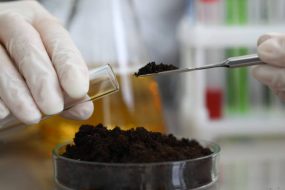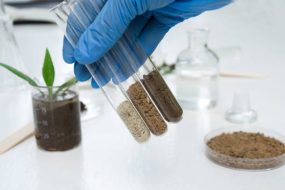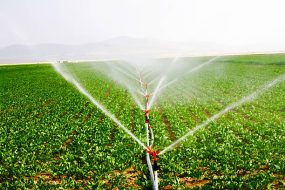When you gaze out at a lush, thriving field of crops, what lies beneath the surface is equally crucial for that abundance. Soil health is the foundation of successful agriculture, and to understand it better, we turn to the world of biological methods for soil fertility evaluation, guided by the ASTM D6913 standard. In this comprehensive guide, we’ll embark on a journey to unlock the secrets hidden beneath the earth’s surface and harness the power of nature for sustainable farming.
Why Soil Fertility Matters
When you walk through a thriving garden or stand amidst a golden field of crops, it’s easy to overlook the unsung hero beneath your feet—soil. Soil, often taken for granted, is not merely dirt; it’s the lifeblood of agriculture and a key player in the food chain. Understanding the importance of soil fertility is crucial for anyone connected to farming, gardening, or environmental stewardship. In this article, we will unravel the secrets of soil fertility and why it matters.

The Foundation of Agriculture
Imagine soil as the canvas upon which nature paints the tapestry of life. It’s the very foundation of agriculture. Soil is where plants anchor their roots, drawing essential nutrients and water to fuel their growth. Whether you’re a farmer tending to acres of crops or a gardener nurturing a small patch of vegetables, soil fertility directly impacts your success.
Read, Also >>>>>>> A Comprehensive Step-By-Step Guide to Evaluation of Soil Fertility Using Chemical Methods
Nutrient Reservoir
Healthy soil acts as a nutrient reservoir, storing essential elements like nitrogen, phosphorus, and potassium. These nutrients are the building blocks of plant growth. When soil fertility is high, it can supply plants with the nutrients they need to thrive. In contrast, nutrient-depleted soil can hinder plant growth, leading to reduced crop yields and poor garden harvests.
Microbial Magic
Beneath the surface, a bustling community of microorganisms carries out a complex symphony of activities. Bacteria, fungi, and other tiny creatures work together to decompose organic matter, making nutrients available to plants. These microorganisms also help to improve soil structure, making it more conducive to root growth and water retention.
Soil Health and Ecosystems
Soil is not just a lifeless substrate; it’s a living ecosystem. A diverse range of organisms calls soil their home, from earthworms to insects to nematodes. This biodiversity is a sign of soil health. Healthy soils are more resistant to diseases and pests, reducing the need for chemical interventions.
Water Management
Soil plays a vital role in managing water. It acts as a sponge, absorbing rainfall and preventing excessive runoff. This helps recharge groundwater and reduces the risk of flooding. Moreover, the soil’s water-holding capacity ensures a steady supply of moisture to plants during dry spells, crucial for crop survival.
Environmental Stewardship
The health of our soil is intrinsically linked to environmental sustainability. Soil that’s rich in organic matter can sequester carbon, mitigating climate change. Healthy soil also filters pollutants from water, improving water quality in rivers and streams. By caring for our soil, we contribute to a healthier planet.
In the grand tapestry of life, soil fertility is the thread that connects us to the land. It’s the key to abundant harvests, thriving ecosystems, and a sustainable future. Whether you’re a farmer, a gardener, or simply a conscientious inhabitant of this planet, understanding why soil fertility matters is the first step towards nurturing and preserving this precious resource. As we delve deeper into the intricacies of soil, we unlock the secrets to healthier crops, a greener environment, and a more food-secure world. So, let’s dig in and appreciate the wonders that lie beneath our feet.
The Role of Biological Methods
Biological methods of soil fertility evaluation focus on assessing the living components of the soil. These methods, as outlined in ASTM D6913, provide a holistic view of soil health. Here’s a breakdown of the key components and how they work:
1. Microbial Biomass Carbon (MBC)
Uncovering the Hidden Currency of Healthy Soil
In the world of soil science, there’s an often-overlooked treasure beneath our feet – microbial biomass carbon (MBC). This unassuming component of soil holds the key to soil health, nutrient cycling, and ultimately, bountiful harvests. In this article, we’ll dig deep into the world of MBC, uncovering its significance and how it influences the vitality of the soil beneath our crops and gardens.
What is Microbial Biomass Carbon (MBC)?
Microbial biomass carbon, abbreviated as MBC, is the carbon stored within the bodies of microorganisms that inhabit the soil. These microorganisms, including bacteria, fungi, and other tiny life forms, are the unsung heroes of healthy soil. MBC serves as their energy currency, powering their metabolic activities and enabling them to perform critical functions in the soil ecosystem.
The Significance of MBC in Soil Health
MBC plays a pivotal role in soil health and fertility. Here’s why it matters:
1. Nutrient Recycling
Microorganisms are nature’s recyclers. They break down organic matter, such as dead plant material and organic residues, into simpler compounds. MBC is the fuel that drives this process. As microorganisms feed on organic matter, they release essential nutrients like nitrogen, phosphorus, and potassium in forms that plants can readily absorb. In essence, MBC powers the nutrient-recycling engine of the soil.
2. Soil Structure Improvement
Healthy soil isn’t just about nutrients; it’s also about structure. Microorganisms secrete substances like glues and polysaccharides that bind soil particles together, creating aggregates. These aggregates improve soil structure, enhancing its water-holding capacity and root penetration. MBC, by sustaining microbial life, contributes to the formation and stability of these aggregates.
3. Disease Suppression
A vibrant microbial community, fueled by MBC, can suppress soil-borne diseases. Some microorganisms produce antimicrobial compounds that inhibit the growth of pathogenic organisms. This natural defense mechanism is essential for maintaining plant health without resorting to chemical treatments.
4. Carbon Sequestration
In an era of climate change, carbon sequestration is a hot topic. Healthy soil, rich in MBC, acts as a carbon sink. Microorganisms incorporate carbon from plant residues into their biomass, effectively storing it in the soil. This helps mitigate the effects of climate change by reducing atmospheric carbon dioxide levels.
Measuring MBC
Assessing MBC involves specialized laboratory techniques. Soil samples are collected and processed to quantify the amount of carbon held within the microbial biomass. These measurements provide valuable insights into soil health and its capacity to support plant growth.
Cultivating MBC for Soil Health
To enhance MBC and, consequently, soil health, consider the following practices:
- Organic Matter Addition: Incorporate organic materials like compost and cover crops into your soil. These provide a food source for microorganisms, boosting MBC.
- Reduced Chemical Use: Minimize the use of synthetic fertilizers and pesticides. Chemicals can harm beneficial microorganisms and reduce MBC.
- Crop Rotation: Rotate crops to diversify the types of organic matter available to microorganisms, promoting a balanced microbial community.
- Reduced Soil Disturbance: Limit soil disturbance through no-till or reduced-till farming practices. This preserves microbial habitats and MBC.
Microbial biomass carbon may be invisible to the naked eye, but its impact on soil fertility and overall ecosystem health is undeniable. It fuels nutrient cycling, supports soil structure, and contributes to disease resistance. As stewards of the land, understanding and nurturing MBC can lead to healthier soils, higher crop yields, and a more sustainable approach to agriculture. In our quest for bountiful harvests and a healthier planet, MBC is a valuable ally beneath our feet.
Microbial Respiration: The Breath of Soil Health
In the intricate world of soil science, microbial respiration is a fundamental process that often goes unnoticed. Yet, it’s the very breath of healthy soil ecosystems, playing a pivotal role in soil fertility and overall ecological balance. In this article, we’ll explore the significance of microbial respiration, how it works, and why it’s a critical indicator of soil vitality.
Understanding Microbial Respiration
Microbial respiration refers to the process by which microorganisms in the soil respire or breathe. Just like humans inhale oxygen and exhale carbon dioxide, microorganisms take in organic matter and release carbon dioxide (CO2) as a byproduct of their metabolic activities. This CO2 production is what we refer to as microbial respiration.
The Significance of Microbial Respiration in Soil Health
Why does microbial respiration matter in the context of soil health? Let’s delve into its importance:
1. Indicator of Microbial Activity
Microbial respiration is a direct reflection of microbial activity in the soil. When microorganisms are active and metabolizing organic matter, they respire more, releasing more CO2. Monitoring CO2 emissions provides insights into the intensity of microbial life in the soil.
2. Nutrient Mineralization
As microorganisms respire, they break down complex organic matter into simpler compounds. This process, known as mineralization, releases essential nutrients like nitrogen, phosphorus, and sulfur into forms that plants can absorb. In essence, microbial respiration fuels the nutrient cycle in the soil, making nutrients available to plants.
3. Soil Organic Matter Decomposition
Microbial respiration is a crucial step in the decomposition of soil organic matter. Organic matter, such as plant residues and dead microorganisms, is broken down by microorganisms. This decomposition contributes to the formation of humus, a stable and nutrient-rich component of soil that enhances soil structure and water-holding capacity.
4. Soil Health Assessment
Monitoring microbial respiration is a valuable tool for assessing soil health. Changes in respiration rates can indicate shifts in the soil microbial community or the impact of management practices. It helps farmers and land managers make informed decisions to maintain or improve soil quality.
Measuring Microbial Respiration
Several methods can be employed to measure microbial respiration in the soil, including laboratory-based techniques and field-based approaches. One common method involves placing soil samples in sealed containers and measuring the increase in CO2 concentration over time. This quantifies the rate of CO2 production, which is directly related to microbial respiration.
Promoting Healthy Microbial Respiration
To enhance microbial respiration and, by extension, soil health, consider the following practices:
- Organic Matter Addition: Incorporate organic materials like compost and crop residues into the soil. This provides a continuous food source for microorganisms, stimulating their activity and respiration.
- Avoid Overuse of Chemicals: Minimize the use of synthetic fertilizers and pesticides, as excessive chemicals can harm beneficial microorganisms and reduce respiration rates.
- Crop Rotation: Rotate crops to diversify the types of organic matter available to microorganisms, promoting a balanced microbial community.
- Maintain Adequate Moisture: Microbial respiration is most active when soil moisture levels are adequate. Ensure your soil has sufficient water to support microbial life.
Microbial respiration is the silent engine driving soil health and fertility. It’s the process by which microorganisms breathe life into the soil, recycling nutrients, decomposing organic matter, and contributing to the overall well-being of ecosystems. Understanding and monitoring microbial respiration can empower farmers, gardeners, and land stewards to make informed decisions that enhance soil health and promote sustainable agricultural practices. In the world of soil science, recognizing the breadth of the soil is a crucial step toward sustainable and productive land management.
3. Soil Enzyme Activities
Unveiling Nature’s Catalysts in Soil Health
Beneath the surface of the Earth, a silent workforce operates tirelessly, carrying out tasks essential for the vitality of soil and, by extension, all life on our planet. These tireless workers are soil enzymes, nature’s catalysts in the intricate world of soil health. In this article, we’ll dive deep into the fascinating realm of soil enzyme activities, understanding their significance, functions, and how they shape the soil beneath our feet.
The Role of Soil Enzymes
Enzymes are biological molecules that speed up chemical reactions. In the context of soil, enzymes act as the facilitators of countless biochemical processes. Soil enzymes are produced and secreted by microorganisms, plants, and even the soil itself. They break down complex organic matter into simpler forms, making nutrients available for plant uptake and contributing to soil fertility.
Key Soil Enzyme Activities
Several soil enzyme activities are crucial for maintaining soil health:
1. Amylase Activity
Amylase is an enzyme that breaks down complex carbohydrates like starch into simpler sugars. Its activity in the soil is essential for the decomposition of plant residues and organic matter, releasing sugars that serve as an energy source for microorganisms.
2. Protease Activity
Protease enzymes break down proteins into amino acids. This process not only releases nutrients like nitrogen but also helps in the breakdown of dead microorganisms and organic matter. It plays a pivotal role in nutrient recycling.
3. Lipase Activity
Lipase enzymes are responsible for breaking down fats and lipids. Their activity contributes to the decomposition of organic matter, releasing fatty acids that can be used by plants and microorganisms.
4. Cellulase Activity
Cellulase enzymes are crucial for breaking down cellulose, a complex carbohydrate found in plant cell walls. Their activity is essential for the decomposition of plant residues, allowing nutrients to be released back into the soil.
5. Phosphatase Activity
Phosphatase enzymes play a vital role in nutrient cycling by releasing phosphorus from organic compounds. This is especially important as phosphorus is an essential nutrient for plant growth.
The Significance of Soil Enzyme Activities
Understanding soil enzyme activities is key for several reasons:
1. Soil Fertility
Enzymes break down organic matter into forms that plants can absorb. By promoting nutrient availability, soil enzymes directly influence soil fertility and plant health.
2. Organic Matter Decomposition
Enzymes are the primary agents responsible for the decomposition of organic matter, including plant residues and dead microorganisms. This decomposition contributes to the formation of humus, a stable component of soil organic matter.
3. Soil Structure
Enzymes, particularly those involved in organic matter decomposition, enhance soil structure. They help create aggregates, improving soil aeration, water-holding capacity, and root penetration.
4. Soil Health Assessment
Monitoring soil enzyme activities provides insights into the overall health of the soil ecosystem. Changes in enzyme activity can signal shifts in microbial communities or the impact of management practices.
Measuring Soil Enzyme Activities
Assessing soil enzyme activities typically involves laboratory analysis. Soil samples are collected and incubated with specific substrates that the target enzymes will act upon. The rate at which the substrate is transformed into a product is used to quantify enzyme activity.
Promoting Healthy Soil Enzyme Activities
To enhance soil enzyme activities and, consequently, soil health, consider the following practices:
- Organic Matter Addition: Incorporate organic materials like compost and cover crops into your soil. This provides a continuous source of organic matter that fuels enzyme activity.
- Reduced Chemical Use: Minimize the use of synthetic fertilizers and pesticides, as they can harm beneficial microorganisms and reduce enzyme activity.
- Crop Rotation: Rotate crops to diversify the types of organic matter available to microorganisms, promoting a balanced microbial community.
- Maintain Adequate Moisture: Enzymes are most active when soil moisture levels are appropriate. Ensure your soil has sufficient water to support microbial life and enzyme activity.
Soil enzyme activities are the unseen architects of soil health, orchestrating the transformation of organic matter into nutrients and shaping the very foundation of ecosystems. Understanding their significance and functions empowers farmers, gardeners, and land stewards to make informed decisions that enhance soil fertility, structure, and overall health. In our quest for sustainable agriculture and a greener planet, recognizing the vital role of soil enzymes is a critical step toward nurturing the soil beneath our feet.
4. Soil Biodiversity
The Hidden World Beneath Our Feet
When we think of biodiversity, our minds often wander to lush forests, coral reefs, or diverse ecosystems teeming with charismatic wildlife. Yet, there’s another realm of biodiversity hidden beneath our feet—soil biodiversity. In this article, we’ll embark on a journey to uncover the remarkable world of soil biodiversity, exploring its importance, the myriad life forms it hosts, and its critical role in sustaining life on Earth.
The Richness of Soil Biodiversity
Soil is far from being a lifeless, inert substance. It’s a vibrant and bustling ecosystem hosting an astonishing diversity of organisms. From microscopic bacteria to earthworms and arthropods, the soil is home to countless species that contribute to its health and functionality.
Key Components of Soil Biodiversity
Let’s dive deeper into the components of soil biodiversity:
1. Microorganisms
Microbes dominate the soil biodiversity scene. These include bacteria, fungi, archaea, and protozoa. They play essential roles in nutrient cycling, organic matter decomposition, and the suppression of soil-borne diseases.
2. Earthworms
Earthworms are perhaps the most recognizable soil organisms. They aerate the soil, improve its structure, and facilitate the breakdown of organic matter. Their burrows also provide pathways for water and root growth.
3. Arthropods
Arthropods such as ants, mites, and springtails are abundant in soil. They contribute to organic matter decomposition and nutrient cycling. Some arthropods are predators, helping control pest populations.
4. Nematodes
Nematodes are microscopic roundworms that inhabit the soil. They are both herbivores and predators, influencing the composition of microbial communities and nutrient dynamics.
The Importance of Soil Biodiversity
Soil biodiversity is not just a curiosity; it’s vital for several reasons:
1. Nutrient Cycling
The diverse community of microorganisms and organisms in soil is responsible for recycling nutrients. They break down organic matter and convert it into forms that plants can absorb, ensuring the availability of essential nutrients for plant growth.
2. Soil Structure
Earthworms and other soil organisms contribute to soil structure by creating channels and aggregates. This improves aeration, water infiltration, and root penetration, all of which are critical for plant health.
3. Pest and Disease Control
Some soil organisms, like certain nematodes and predatory arthropods, help control pest populations. They act as natural enemies of harmful insects and pathogens, reducing the need for chemical interventions.
4. Carbon Sequestration
Soil biodiversity contributes to carbon sequestration. Microbes and organisms incorporate carbon from plant residues into the soil, helping mitigate climate change by storing carbon below ground.
Conservation and Promotion of Soil Biodiversity
To conserve and promote soil biodiversity, consider the following practices:
- Reduced Soil Disturbance: Minimize practices like excessive tilling that can disrupt soil ecosystems.
- Organic Matter Addition: Incorporate organic materials like compost and cover crops into your soil to provide a continuous source of food for soil organisms.
- Crop Rotation: Rotate crops to diversify the types of organic matter available to soil organisms.
- Reduced Chemical Use: Limit the use of synthetic fertilizers and pesticides that can harm beneficial soil organisms.
Soil biodiversity is an often-overlooked treasure, yet it’s a fundamental component of healthy ecosystems and sustainable agriculture. Beneath our feet, a complex web of life sustains the fertility of our soils, the productivity of our crops, and the health of our planet. Recognizing and nurturing soil biodiversity is not only a scientific endeavor but a profound act of environmental stewardship, ensuring that life thrives from the depths of the Earth to the heights of the sky.
How to Perform Biological Soil Fertility Evaluation (ASTM D6913)
Now that we’ve uncovered the significance of these biological methods let’s explore how to perform them as per the ASTM D6913 standard:
Unlocking the secrets of soil fertility through biological evaluation, as outlined by the ASTM D6913 standard, is a powerful tool for farmers, researchers, and environmental stewards. This comprehensive guide will walk you through the step-by-step process of performing biological soil fertility evaluation to gain invaluable insights into your soil’s health and vitality.
1. Sample Collection
a. Select Representative Sampling Sites
Begin by selecting representative sampling sites across the area of interest, such as a field or garden. Ensure that the chosen locations accurately reflect the variability of your soil.
b. Collect Soil Samples
Using a soil corer or auger, collect soil samples at various depths, considering the root zone of the plants in question. Typically, you’ll want to collect samples from the surface down to a depth of about 6-12 inches (15-30 cm).
c. Label and Document
Properly label each sample container with the corresponding sampling location, depth, and any other relevant information, such as the date of collection. Detailed documentation is crucial for accurate interpretation.
2. Laboratory Analysis
Once you have collected your soil samples, it’s time to send them to a reputable soil testing laboratory for analysis. Here’s what to expect during the laboratory analysis:
a. Microbial Biomass Carbon (MBC) Measurement
The laboratory will determine the amount of microbial biomass carbon (MBC) in your soil samples. This is typically done using techniques such as chloroform fumigation extraction or substrate-induced respiration. MBC represents the carbon content within microbial cells.
b. Microbial Respiration Assessment
Microbial respiration rates are determined by measuring the release of carbon dioxide (CO2) from the soil samples. The laboratory will incubate the soil and monitor CO2 production over a specified period, usually 24-48 hours.
c. Soil Enzyme Activities Analysis
Soil enzyme activities, such as amylase, protease, and phosphatase, are assessed through specific assays. These tests provide insights into the soil’s ability to break down complex organic compounds into simpler forms.
d. Soil Biodiversity Assessment
Soil biodiversity analysis may include examining the diversity and abundance of microorganisms through techniques like DNA sequencing or microscopy. It can also involve counting larger soil organisms, such as earthworms or arthropods.
3. Interpretation of Results
Once you receive the laboratory results, it’s time to interpret them. Here’s how:
a. Compare to Reference Values
Compare the values obtained for MBC, microbial respiration, enzyme activities, and soil biodiversity to reference values or standards specific to your crop type or soil type. These values can guide you in assessing your soil’s health.
b. Identify Areas for Improvement
Identify areas where your soil may be lacking or where values deviate significantly from the reference values. For example, low MBC may indicate a need for organic matter addition, while imbalanced enzyme activities may suggest nutrient imbalances.
c. Develop a Soil Management Plan
Based on the results and identified areas for improvement, develop a tailored soil management plan. This plan may include amendments like compost, cover cropping, or adjustments to your irrigation and fertilization practices.
Performing biological soil fertility evaluation according to ASTM D6913 is a valuable investment in understanding your soil’s health and potential. By following these steps and leveraging the insights gained from the analysis, you can make informed decisions to improve soil fertility, promote sustainable agriculture, and ensure the long-term productivity of your land.
Benefits of Biological Soil Fertility Evaluation
So, why should you consider adopting these methods?
- Biological soil fertility evaluation, a process that delves into the living components of soil ecosystems, offers a multitude of benefits for farmers, researchers, and environmentalists alike. This article explores the advantages of embracing biological methods, shedding light on how they can transform soil management practices and pave the way for sustainable agriculture.
1. Precision Farming
One of the primary benefits of biological soil fertility evaluation is precision farming. By understanding the microbial life, enzyme activities, and overall biological health of your soil, you can tailor your soil management practices to specific areas of your field. This targeted approach optimizes resource allocation, reduces waste, and enhances crop yields where they matter most.
2. Sustainable Agriculture
Biological methods align seamlessly with the principles of sustainable agriculture. Unlike traditional approaches that rely heavily on synthetic fertilizers and pesticides, biological evaluations encourage natural, organic solutions. This reduces the ecological footprint of farming, minimizes chemical runoff, and promotes a more harmonious relationship between agriculture and the environment.
3. Cost Savings
Healthy soil translates into cost savings for farmers. By optimizing nutrient use and enhancing soil health, biological methods can reduce the need for expensive synthetic inputs like fertilizers and pesticides. Over time, this can significantly lower production costs, improving the economic sustainability of farming operations.
4. Environmental Benefits
Healthy soils contribute to a healthier environment. Biological soil fertility evaluation promotes practices that minimize the environmental impact of agriculture. Reducing the reliance on chemical fertilizers and pesticides, it mitigates the risk of water pollution and soil degradation, benefiting not only farms but also surrounding ecosystems.
5. Improved Soil Resilience
Biologically healthy soils are more resilient in the face of environmental stresses. Diverse microbial communities and robust soil structures can withstand adverse conditions such as drought or heavy rainfall, reducing the risk of crop failure. This resilience is a valuable asset in an era of climate uncertainty.
6. Enhanced Nutrient Cycling
Biological methods support efficient nutrient cycling in the soil. Microorganisms break down organic matter and make essential nutrients available to plants. This natural nutrient recycling process ensures that crops have access to the nutrients they need for optimal growth, reducing the risk of nutrient imbalances.
7. Long-Term Success
Investing in biological soil fertility evaluation sets the stage for long-term success. As soil health improves, the benefits accrue over time. Healthier soils require less intervention, leading to more stable and consistent crop yields season after season.
The benefits of biological soil fertility evaluation extend far beyond the farm gate. By embracing these methods, farmers can achieve precision in their practices, reduce costs, and contribute to a more sustainable and environmentally friendly agricultural landscape. As we navigate the challenges of feeding a growing global population while safeguarding our planet, biological soil fertility evaluation emerges as a powerful ally, nurturing the soil, the crops it supports, and the future of agriculture itself.
Conclusion
In the grand tapestry of agriculture and environmental stewardship, soil is the unsung hero, silently supporting life and sustaining our planet. The journey we’ve taken through the world of soil, from understanding its importance to exploring its biological intricacies, has illuminated the vital role it plays in our lives.
We’ve learned that soil fertility isn’t just a matter of chemical composition; it’s a dynamic, living ecosystem. From microbial biomass carbon (MBC) to microbial respiration, soil enzyme activities, and the rich tapestry of soil biodiversity, we’ve delved into the biological methods that unlock the secrets of soil health.
Through biological soil fertility evaluation, as outlined by ASTM D6913, we’ve gained the ability to peer beneath the surface and uncover the hidden world of soil. This knowledge empowers us to practice precision farming, promote sustainability, and reduce costs while nurturing the environment.
By prioritizing healthy soil, we contribute to a greener, more sustainable future. Healthy soils not only support bountiful harvests but also protect our water resources, sequester carbon, and enhance the resilience of agriculture in the face of a changing climate.
As we move forward, let’s continue to appreciate the wonders that lie beneath our feet. Soil, with its biological richness, is not just dirt—it’s the foundation of life, the source of our sustenance, and a symbol of our responsibility as stewards of the Earth.
Read, Also >>>>>>> A Comprehensive Step-By-Step Guide to Evaluation of Soil Fertility Using Chemical Methods











